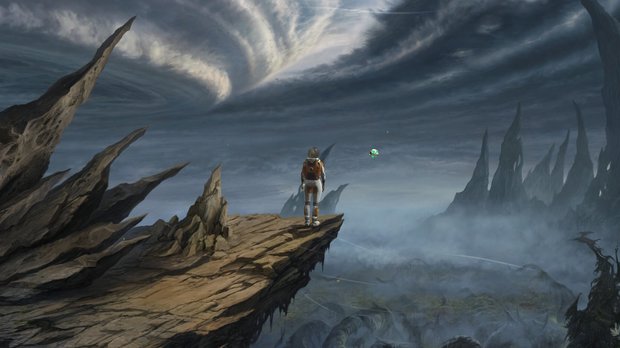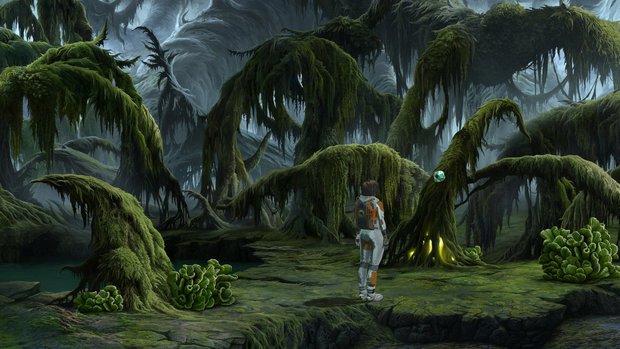Monolith review

- 0 Comments
Animation Arts constructs a gorgeous, rock-solid sci-fi adventure eroded somewhat by a lack of polish
Stop me if you’ve heard this before: In this era where a daily deluge of entertainment options are available and attention spans are shorter, if you don’t grab the player almost immediately you run the risk of your game not being played at all. With Monolith, Animation Arts (Lost Horizon, Secret Files series) returns from a lengthy absence to deliver an overall solid third-person point-and-click adventure in the well-worn isolated astronaut subgenre. Yet I fear many players won’t be willing to see it through, as every one of the game’s weaknesses are highlighted in all their infamy in the first hour of play.
A gorgeous opening cutscene follows our protagonist Tessa Carter as her ship crash lands on an unfamiliar planet. She discovers her copilot is missing along with not-insignificant chunks of her memory, including the purpose of their mission. Exploring the ship only adds to her confusion, as she discovers that he appears to have left her abandoned.
The first issue that immediately pulled me out of the story is some glaringly bad lip-syncing. Tessa frequently talks out loud to herself (we’ll get back to that in a minute) and it’s difficult to focus on the words rather than her face unless you close your eyes. It’s especially noticeable at the beginning, as the opening sequence contains the most prominent close-ups of Tessa’s character model. Speaking of which, the model feels straight out of an adventure from 2007, with poorly defined hair and muscle tone. Thankfully, these issues become less pronounced as the game progresses, as Tessa wears her space suit almost exclusively, and as she explores the planet the camera zooms out, deemphasizing focus on her appearance and the movement of her lips.

More glaringly, and perhaps in part due to poor localization from the original German script, Tessa’s solo conversations are pure cringe. While that adjective is admittedly subjective, I present to you some prominent examples:
– After a previously and understandably anxious Tessa puts on her spacesuit: “That’s so nice. So comfy and warm. Watch out planets!”
– After first leaving the ship and stepping out onto the planet: “I was hoping for a world thriving with interesting flora and fauna.” Tessa can’t remember anything about her mission and is desperately looking for her partner. Why would she be worrying about the flora and fauna?
– “Huh, as if!” which should probably never be said, especially when the character is anxious!
– Some poorly written technobabble: “There are wires hanging out. They might be jamming the energy supply.”
– To cap it off, an incorrect idiom as Tessa is attempting a last-ditch effort: “This is the last straw.”
It doesn’t help that the voice acting in general is fairly wooden, with the key exception of one non-organic character. There are several conversations between humans and in every one it feels like the actors are reading their lines with their heads down in the script. And once again the script doesn’t always help matters here. There are several flashback scenes where Tess and her husband are talking, and they sound like strangers to one another. Her husband is frequently encouraging and thoughtful, but rather than coming off like someone who knows her inside and out, he talks to her like a motivational speaker to a general audience.
But! As deep a hole as Monolith digs for itself early on, suddenly it starts to climb out. And the reason is primarily C.O.R.E., a small floating robot Tessa finds in the ship’s storage, who is a cross between Wheatley from Portal 2 and ASE from Deliver Us the Moon. Not only does he/it provide Tessa someone to talk to other than the ether, and offers considerable support (we’ll also get back to that in a minute), Tessa instructs him to be witty and sardonic to keep her entertained. And boy does C.O.R.E. deliver. He frequently and sarcastically calculates out loud her probability of death, relentlessly teases her when she makes mistakes, and promises her accurate scans of any dangerous animals before they kill her (to be clear, it’s impossible to die). I laughed out loud at least a half a dozen times. While C.O.R.E. saves Tessa a few times, more importantly, he saved this game from the brink.

As Tessa leaves the crash site to explore the planet, the story becomes engaging and dare I say thrilling at times. With C.O.R.E. accompanying her, Tessa braves the harsh planet conditions before arriving at a mining outpost, and to her surprise it belongs to the company she works for. After making her way in, she is faced with locked doors, powerless computer consoles, laboratories with conveniently helpful scientific notes lying about, and most importantly, a stranger who doesn’t register on C.O.R.E’s sensors yet frequently sabotages Tessa’s efforts while eluding her grasp. This middle section, which comprises about 75% of the game, is where all the fun lies.
While Monolith’s first few puzzles (including one where you reconnect dangling wires) are inane guess-and-check exercises, most everything from there on out is a prime example of good sci-fi puzzle design. The mostly inventory-based puzzles feel organic to the story, realistic roadblocks to getting the station up and running. They’re grounded in science (while being accessible to the average player) and range from mixing chemicals and utilizing medical devices to fixing the station’s equipment and analyzing computer data. C.O.R.E. is able to scan each room to provide Tessa with helpful information about her surroundings while also teaching her basic science principles to guide her. It also has the ability to project holographic conversations that occurred on the station before it was abandoned; while this ability is a bit of a contrived trope, it’s nevertheless a fun way to provide information and story pacing.
I also appreciate that many inventory items are used for multiple puzzles, including combining items and sometimes uncombining them to reuse one of the parts. And while few puzzles have alternate solutions, the game often acknowledges your other ideas and explains why they don’t quite work. A space-bar-activated hotspot highlighter (which can be turned off for those disinclined) is a welcome relief in the rare instances where you miss something that in retrospect wasn’t that hard to find. On the other hand, the hint system disappointingly gives you the whole answer when just a point in the right direction is all that’s desired.

The visuals are a mixed bag. The hand-drawn locations are universally gorgeous and finely detailed. The crash site is highlighted by a panoramic view of the planet’s two suns, and Tessa’s jaunt through a vibrant jungle (which funnily enough contains plenty of interesting and suitably alien flora and fauna) is a welcome contrast to the desolate barren rock she started out on. The station itself could have been sterile, but instead each room feels unique and lived-in at one point, even if long since deserted.
At certain times, however, the integration with Tessa’s character model isn’t perfect, occasionally looking like she’s walking on top of a matte painting. The animations run the gamut: Some seemingly simple animations (like picking up a small object instead of grabbing air) aren’t implemented at all, which would be fine if it wasn’t contrasted by some truly fine animations, such as Tessa inserting and then cranking a handle to open a door. And some are just ... awkward. Early on, Tessa ignites something on fire and is shown putting the FIRE in her non-existent pockets. Sometimes it’s better to just not animate at all and lean into the suspension of disbelief players accept with juggling inventory.
The music for the most part is good at conveying the current mood, whether the tranquility of the jungle or the intensity of chasing or being chased by the aforementioned stranger. Though in just a few instances the voice leveling is off, requiring you to raise the volume to hear conversation only to be jolted a few seconds later when the music comes on. Sound effects are appropriately science-fictiony.
The point-and-click user interface is friendly; every action, be it looking at or taking or combining items, is performed with a left-click, while a right-click reveals an unobtrusive inventory panel on the right-hand side. Despite the minimalist functions, nothing feels overly simplified; I never gave a second thought to the controls while playing, which is a good feature in my book. Peculiarly, while the game allows for more save slots than you’ll ever need, they are all erased once you finish the game. For those wanting to replay certain sections, it’s quite the bummer to have to start from scratch.
The endgame, which I found particularly disappointing, is where some players will be divided. Most of the overarching story is told (in excruciatingly long cutscenes) between chapters, with Tessa recounting her mission to a doctor while lying in a hospital bed. The framing device works just fine and nothing important is given away ahead of time. But once you catch up to present day, the plot twists in such a way that overshadows the story up to that point in order to pound the player over the head with allegory and a special lesson. It doesn’t negate what came before it as such, and if the surprise ending allowed you to experience and interpret the allegory for yourself, I probably would have liked it. But you are not trusted to pick it up on your own, and in the end it feels like watching an after-school special.
Final Verdict
So with the high highs and the low lows, which players am I recommending play Monolith? If you’re jonesing for plenty of science fiction puzzles and enjoy your character being the victim of some witty condescension, this should be worth the seven to ten hours of playtime, despite the initial slog and late letdown. On the other hand, if you’re mostly into adventure games for the story, good acting and realistic dialogue, then pass this one by to save yourself the frustration. It seems fairly evident that the game is a victim of budget constraints and less-than-optimal localization, which is probably why it remained in limbo for so many years. And that’s a shame, because otherwise it largely manages to stand tall as a welcome return from Animation Arts.
Hot take
Monolith earns science fiction cred with a witty sidekick robot, a beautifully drawn alien world and many clever puzzles relevant to the genre, though an uneven story, shaky dialogue, and poor characterizations may turn off players less willing to endure them to get to the good parts.
Pros
- Robot companion is a helpful scientific guide and legit funny
- A slew of engaging and story-related science fiction puzzles
- Hand-drawn locations are stunning
Cons
- Weak dialogue and acting (robot excepted) hamper a generally interesting story
- Some polishing needed with lip-syncing and animations
- Ending is heavy-handed
Beau played Monolith on PC using a review code provided by the game's publisher.










0 Comments
Want to join the discussion? Leave a comment as guest, sign in or register in our forums.
Leave a comment